In the last decades, climate change has emerged as one of the most urgent and widely discussed issues worldwide. From politics to science, from economics to social movements, climate change affects every aspect of our lives. Various ways to solutions have been outlined. Is Europe taking the lead, or is the continent lagging slightly behind?
What about Europe?
Europe is seen as a leader in climate policy. However, the division on economic and political fronts makes the fight against climate change more complex, as different countries have varying priorities and resources to achieve the goals. It is uncertain whether Europe can live up to its role as a leader.
The mission against emission
The European Union (EU) is prioritizing the implementation of the European Green Deal (EGD) over further increasing its climate ambitions. Despite notable progress, the EU remains off track to meet its 2030 target of reducing emissions by 55% from 1990 levels, with the Climate Action Tracker (CAT) rating its efforts and goals as “Insufficient.” Nonetheless, the adoption of EGD measures has brought the EU closer to achieving its targets, though additional efforts are needed to fully align with its climate objectives.
Since 1990, the EU has steadily reduced greenhouse gas emissions, achieving a 37% decrease by 2023, including an 8% drop from 2022. This recent reduction, the largest in decades outside the pandemic’s temporary effects, was driven by greater reliance on renewable energy and reduced coal and gas use.
The EGD has accelerated progress. Policies before its introduction in 2019 projected only a 33% reduction by 2030, while current measures forecast a 52% decrease. In 2024, the EU implemented several impactful initiatives, including revisions to the Energy Performance in Buildings Directive, the Gas Regulation and Directive, and the Methane Regulation. These policies focus on improving building energy efficiency, phasing out fossil fuels, developing a hydrogen market for industrial and shipping decarbonization, and mandating methane monitoring in the fossil fuel sector.
While these steps are positive, gaps remain, such as missed opportunities for concrete fossil fuel phase-out targets. At COP28, the EU called for a global phase-out of “unabated” fossil fuels but has yet to establish domestic targets, a critical move given its role as a major fossil fuel importer.
The EU’s proposed 2040 target aims for a 90% reduction in emissions from 1990 levels, but it lacks a specific 2035 target. CAT suggests that the EU should aim for at least a 78% reduction by 2035 and recommends further actions to strengthen its climate agenda. These include halting investments in new fossil gas infrastructure, committing to coal phase-out by 2030 and fossil gas by 2035, restricting carbon capture and storage (CCS) to sectors without alternatives, and increasing climate finance through mechanisms like the Carbon Border Adjustment Mechanism (CBAM). Additionally, the EU must update its strategy to ensure Member States make sufficient progress toward climate neutrality.
The battle on biodiversity

Europe’s ecosystems are among the most degraded in the world, with urbanization, intensive farming, and deforestation leaving habitats fragmented. Political resistance to binding measures further undermines progress. The EU has the instruments to become a transformative actor to reverse biodiversity loss. So far, however, the translation into action has proved difficult.
Central to Europe’s biodiversity efforts is the Nature Restoration Law, which mandates member states to restore degraded ecosystems and protect vital habitats. This legislation builds on the EU’s broader environmental framework, including the Habitats Directive, aimed at conserving species and ecosystems critical to biodiversity. Reine Spiessens, biodiversity policy officer at WWF, underscores the law’s significance: “This law is a crucial step for Europe, signalling a strong commitment to global biodiversity goals. With 81% of Europe’s protected habitats in poor condition, this law is essential to halt biodiversity decline.”
The law also aligns with global ambitions to restore 30% of degraded ecosystems by 2030. However, Europe’s internal biodiversity crisis raises doubts about its leadership. Belgium serves as a striking example, with 95% of its protected habitats in poor condition, earning it the title of “the worst student in the European class.”
Ambitious EU targets are hindered by limited resources, competing political priorities, and the complexity of restoring fragmented ecosystems. Spiessens highlights a key challenge: “Securing sufficient funding for nature restoration remains a significant hurdle. Reaching the 2050 goals requires long-term planning and immediate action.”
Despite its framework, Europe’s efforts often lack the urgency seen elsewhere. Spiessens warns that failure to act could damage the EU’s global credibility: “Without this law, Europe would send the wrong message to the world about its commitment to biodiversity protection. While the law marks a significant step, the real challenge lies in implementation.”
Although the EU positions itself as a leader in addressing biodiversity loss, its ability to deliver remains uncertain. The Nature Restoration Law provides a crucial foundation, but it is only the beginning. To meet its targets, the EU must bridge funding gaps, accelerate restoration efforts, and maintain political commitment over the long term.
The strategy of renewable energy
“Technological costs for solar and wind energy have dropped significantly, which has greatly helped in decarbonizing our energy system. However, some challenges remain.“ François Dejean, head of the Climate Advisory Board.
The transition into using more renewable energy is happening now across Europe. 75% of EU emissions are linked to energy use, so the importance lays in the potential success. Within a single year, Europe’s mix of energy grew from 21.9% in 2021 to 23% in 2022. The objective is stretching: 42.5% by 2030. Sweden, Finland and Latvia will be paving the path forward but others have a long way to go.
The EU desires new client sectors by having a blueprint of bringing down carbon emissions across commercial enterprises, increasing the number of wind farms erected on the coast and promoting practices that consider the environment. With regards to energy, the regions around the North Sea are planting the seeds of large ocean energy plants while Spain and Germany are gaining ground in solar energy. Hydropower, the lifeblood of many Norwegian and Austrian territories, has and will always be an important factor.
The capacity to provide energy in Europe is not an issue, it is the management of energy storage and maintenance of the networks which will take in wind and sun-generated power throughout Europe. All of it is a component of the European Green Deal which envisions the continent to be free of emissions by the year 2050. This stands for such key technologies as green hydrogen for none dietary superindustries and the building of additional high powered infrastructure.
The possibility of industrial sustainability
“Climate change is real and it is out of control. Every half-degree beyond two degrees makes the impact on society and ecosystems greater.” Jeremy Caradonna, sustainability expert and US historian
Mitigating climate change is a priority for the European Union as they outline in the European Green Deal, Green Deal Industrial Plan and Net-Zero by 2050 vision. The EU is focused on driving innovation in green technologies, renewable energy and circular economies and through initiatives such as InvestEU, is investing in the production of wind turbines, batteries and solar panels. The European Union is revered in Carodonna’s entries “The European Union is a global leader, and they should be proud of their work, because many other regions look to them for inspiration, and the EU has been a leader in eastern expansion.”
The EU Circular Economy Action Plan is aimed at reusing and recycling waste and construction and textile products that have enduring value. Member states such as Denmark, Germany have managed to become successful in using renewable energy an phasing out coal. The difference with the model of domestic GDP is that the EU respects well-being, nature to be prioritized even in policy formulation.

US historian Jeremy Caradonna underscored the importance of the EU acting as a united body, “Climate change is real and yes it is out of control, and every half-degree beyond two degrees makes the impact on society and ecosystems greater. The EU’s ambitious measures show an understanding of this urgency, setting an example for the rest of the world.” In fact, the EU’s political resolve set an example to the entire world.
European Battery Alliance and Horizon Europe are examples of initiatives which will support the advancement of sustainable batteries, the study of carbon capture, and climate-friendly materials. If the East still struggles with fake news and imbalances, the good news is that European efforts in embedding sustainability in industrial policy trigger some international movement.
International teamwork makes the dream work
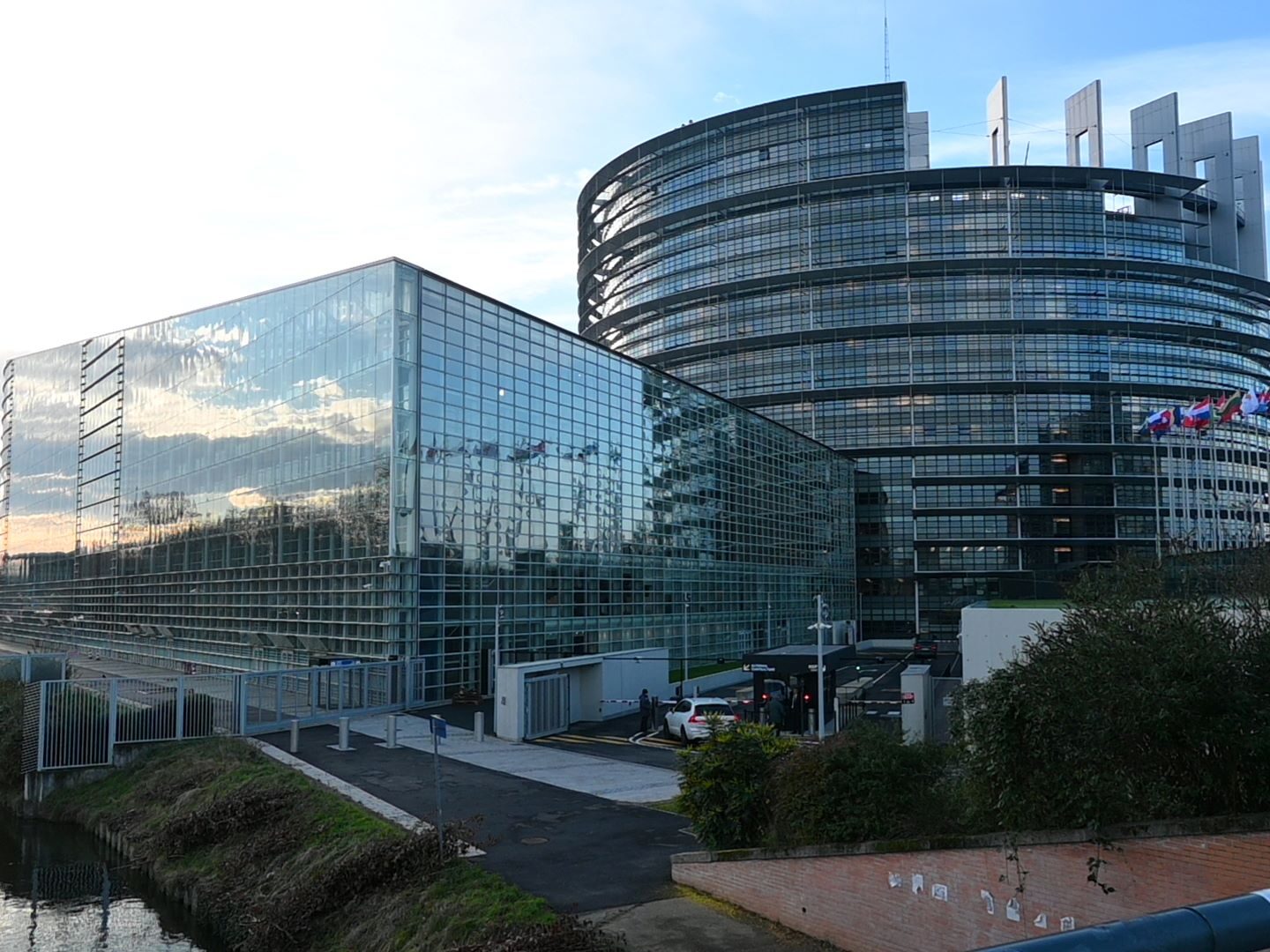
The EU is prioritizing the European Green Deal (EGD) to achieve its climate goals, though it remains off track to meet its 2030 target of a 55% emissions reduction from 1990 levels. The Climate Action Tracker (CAT) rates the EU’s efforts as insufficient, despite significant progress driven by EGD measures. Since 1990, the EU has reduced emissions by 37%, including an 8% drop in 2022–2023, the largest in decades outside the pandemic’s effects, thanks to increased renewable energy use and reduced coal and gas consumption.
The EGD has accelerated emissions cuts, with current measures projecting a 52% reduction by 2030 compared to 33% under pre-2019 policies. Recent initiatives include the Energy Performance in Buildings Directive, Gas Regulation and Directive, and Methane Regulation, focusing on energy efficiency, hydrogen market development, and methane monitoring.
However, gaps remain. While the EU advocates globally for a fossil fuel phase-out, it lacks concrete domestic targets. CAT recommends a 78% emissions reduction by 2035, ending investments in new fossil gas infrastructure, phasing out coal by 2030 and gas by 2035, and limiting carbon capture to sectors without alternatives. The EU must also update its strategy to ensure all member states progress toward climate neutrality.
Despite advances, stronger domestic commitments and decisive actions are essential for the EU to align fully with its climate objectives and maintain momentum.
What about the rest of the world?
After analyzing Europe, it is equally important to examine other major players in the field of climate policy. This is essential for conducting a critical analysis of whether Europe is a leader in this area or lags behind. We chose specific countries and continents based on their significance and the impact of their climate policies.
The mission against emission
Africa
Africa endures the harshest impacts of climate change while contributing the least to its causes. “Africa is responsible for less than 10% of global greenhouse gas emissions. But it is the continent which is the least able to cope with the negative impacts of climate change. Heatwaves, heavy rains, floods, tropical cyclones, and prolonged droughts are having devastating impacts on communities and economies, with increasing numbers of people at risk,” said WMO Secretary-General Prof. Petteri Taalas. 18 of the 54 African countries have a net zero pledge.
China
China aimed to reduce carbon emissions by 18% between 2020 and 2025, but this goal was not achieved due to the impact of the COVID-19 pandemic. Currently, 58% of China’s energy is still generated from coal, which complicates efforts to reduce emissions.
To meet the long-term goals of the Paris Climate Agreement (2016), China has planned several steps. By 2030, the country expects a peak in CO₂ emissions, after which a decline should follow. China aims to reduce emissions by 30% by 2035.
In its journey toward carbon neutrality by 2060, China seeks to become less dependent on coal. To achieve this, the country is focusing on nuclear energy, renewable energy sources, and natural gas as alternative energy sources.
However, it’s important to remember that China is the world’s largest producer of solar panels and wind turbines, and manufacturing these products requires significant energy, which leads to high CO2 emissions.
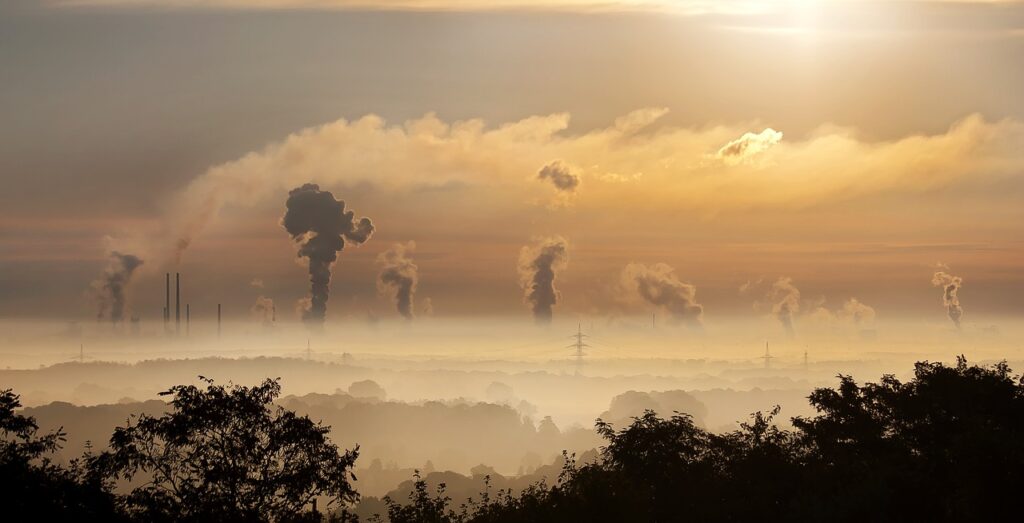
USA
The cornerstone of U.S. air quality regulation is the Clean Air Act (CAA). This act empowers the Environmental Protection Agency (EPA) to regulate air pollutants. For example, in the National Ambient Air Quality Standards (NAAQS), the EPA sets standards for pollutants like carbon.
The U.S. also addresses greenhouse gasses under the Clean Air Act and other policies like the Vehicle Emissions Standards. The EPA regulates CO₂ emissions from power plants through programs like the Affordable Clean Energy (ACE) rule (which replaced the Clean Power Plan). With specific rules to limit methane emissions from the oil and gas sector, the U.S. regulates Methane.
States also have their own policies. California, for example, has a waiver under the CAA allowing it to set stricter vehicle emissions standards, which other states often adopt.
Even more regional programs like the Regional Greenhouse Gas Initiative (RGGI). This involves states in a cap-and-trade system to reduce CO₂ from power plants.
Russia

Russia aims to reduce greenhouse gas emissions by 30% by 2030, based on 1990 levels. While this target seems ambitious, it is largely due to the economic collapse after the fall of the Soviet Union. Since then, emissions have remained almost constant, partly due to dependence on fossil fuels. Russia uses its vast forests as its main means of offsetting carbon emissions, but its effectiveness is disputed by scientists. Forests suffer from poor management and many forest fires, reducing their role as carbon stores. Methane reduction, essential because of the large natural gas industry, is given low priority, despite international pressure and its importance in climate mitigation.
Did you know?
Russia is home to the world’s largest forest areas, including the Siberian forests. These forests play a crucial role in absorbing CO2, but illegal logging and wildfires threaten their ability to absorb CO2. Wildfires, especially in the summer, lead to significant carbon dioxide emissions.
South America
In South America they don’t have one plan for the whole continent. Every country has an own plan. Because they don’t have an organisation like the European Union. And some countries focus on other things first because they don’t use a lot of fossil fuels. Those are mostly Latin American countries like: Trinidad, Tobago and Venezuela. But most of the countries try to reach net zero by 2050, some by 2030.
South America doesn’t really do emission trading because they don’t have a Union. And all countries focus on different things. You have Amazonian countries who have parts of the amazon rain forest in them who don’t need to worry about emissions that much because of the Amazon, they are more focused on deforestation.
India
India has set ambitious goals to tackle emissions and shift towards a more sustainable energy landscape. By 2030, the country aims to reduce its emissions intensity by 45% compared to 2005 levels, and it plans to source 50% of its energy needs from non-fossil fuels by the same year. India has committed to reaching net-zero emissions by 2070. A major focus is on expanding renewable energy capacity, especially in solar and wind power.
To manage emissions, India is exploring various market-based approaches. The country has taken inspiration from systems like the EU Emissions Trading System (ETS), which allocates emission rights by sector, with strict limits set for energy-intensive industries. India’s own Perform, Achieve, and Trade (PAT) Scheme, launched in 2012, allows industries to trade energy-saving credits as a way to improve energy efficiency.
India is actively considering carbon pricing and trading mechanisms to create a carbon market, with several pilot projects already underway. For example, the state of Gujarat has implemented a regional emissions trading system to better control air pollution, serving as a potential model for broader national adoption.
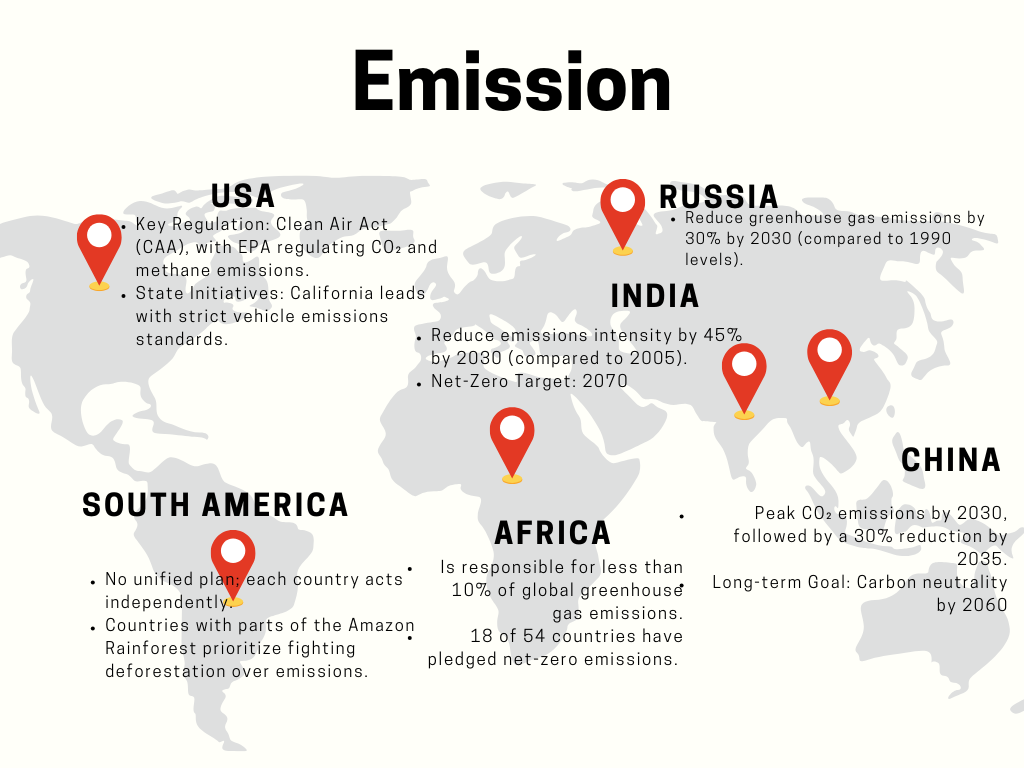
The battle on biodiversity
Africa
Africa is home to extraordinary biodiversity, but climate change is putting immense pressure on its ecosystems. Rising temperatures, droughts, and floods are altering habitats, forcing many species to migrate or face extinction. Coral reefs are bleaching, forests are being cleared, and deserts are expanding, disrupting both wildlife and the people who rely on nature for survival.
Despite these challenges, efforts are underway to protect Africa’s biodiversity. National parks, reforestation projects, and sustainable farming practices are helping to preserve habitats. Protecting Africa’s rich ecosystems is critical, not just for the continent, but for the planet as a whole.
China
China’s biodiversity policy is based on the Biodiversity Conservation Strategy and Action Plan (2023-2030). This action plan focuses on restoring and protecting ecosystems while allowing for economic development. By 2025, China aims to protect 18% of its land area through nature reserves, increase forest cover to 24.1%, and protect 55% of wetlands and 35% of natural coastlines. Additionally, 77% of key animal species will be placed under state protection.
By 2030, China plans to restore 30% of its damaged natural areas, focusing on making forests, rivers, coastal areas, and oceans healthy again. China also plans to financially support regions that contribute to nature conservation as compensation. Furthermore, it aims to integrate biodiversity into green finance and corporate sustainability reporting.
By 2035, China seeks to increase forest cover to 26% and improve wetland protection to 60%. They are taking measures such as national parks and provincial plans to protect nature, despite challenges like climate change and habitat loss. These ambitious goals highlight China’s leadership in global biodiversity initiatives.
Did you know?
China has more than 34,000 plant species, making it one of the most biodiverse countries in the world. The Yunnan Province alone hosts nearly half of the country’s plant species!
USA
The United States is leading efforts to reverse the decline in biodiversity globally by advancing conservation of lands and waters, combating drivers of nature loss, protecting species, and supporting sustainable use, while also enabling healthy and prosperous communities through sustainable development.
Russia

Russia’s climate policy lacks scientific support and relies on false solutions, according to Tatiana Lanshina, a former Russian Presidential Academy employee. She argues that the best scenario would be Putin’s removal, citing a lack of political will for real climate action. While Russia aims to reduce emissions by 30% by 2030, largely due to the post-Soviet economic collapse, emissions remain steady due to fossil fuel dependence. Forests, crucial for CO₂ offset, suffer from poor management and wildfires, and methane reduction in the gas industry is neglected. Renewables make up just 0.6% of energy, with natural gas dominating. Industry’s fossil fuel reliance and limited efficiency funding slow sustainable tech adoption. Internationally, Russia’s efforts are hindered by sanctions, the Ukraine war, and reduced EU trade, while domestically, forests are symbolic. Biodiversity faces threats from mismanaged forests and wildfires, reducing CO₂ storage and harming ecosystems. Without reforms, Russia’s climate efforts will fall behind, struggling with fossil fuel dependence and biodiversity preservation.
South America
South America is one of the most biodiverse regions on Earth, home to the Amazon Rainforest, the Andes, and the Pantanal. This natural wealth supports countless species, but deforestation, climate change, and illegal mining are causing significant damage. Rising temperatures and changing rainfall patterns fuel droughts and wildfires, while agricultural expansion and logging destroy critical habitats and release vast amounts of carbon.
Efforts to protect this biodiversity include expanding protected areas, supporting indigenous-led conservation, and transnational initiatives like the Amazon Cooperation Treaty Organization (ACTO). However, balancing conservation with economic pressures remains a major challenge for the region and the planet.
India
India is a biodiversity hotspot, home to diverse ecosystems ranging from forests to coastal mangroves and the Himalayas. Climate change poses a significant threat to this biodiversity, with rising temperatures and extreme weather impacting native species and habitats.
In response, India is integrating biodiversity conservation into its climate strategy. Efforts include expanding protected areas, restoring forests, and promoting sustainable agriculture. Projects like the Green India Mission aim to boost carbon sinks while preserving ecosystems. Wetlands and mangroves, crucial for carbon storage and biodiversity, are also being protected to enhance climate resilience. Local communities play a key role in these initiatives, combining conservation with sustainable livelihoods.
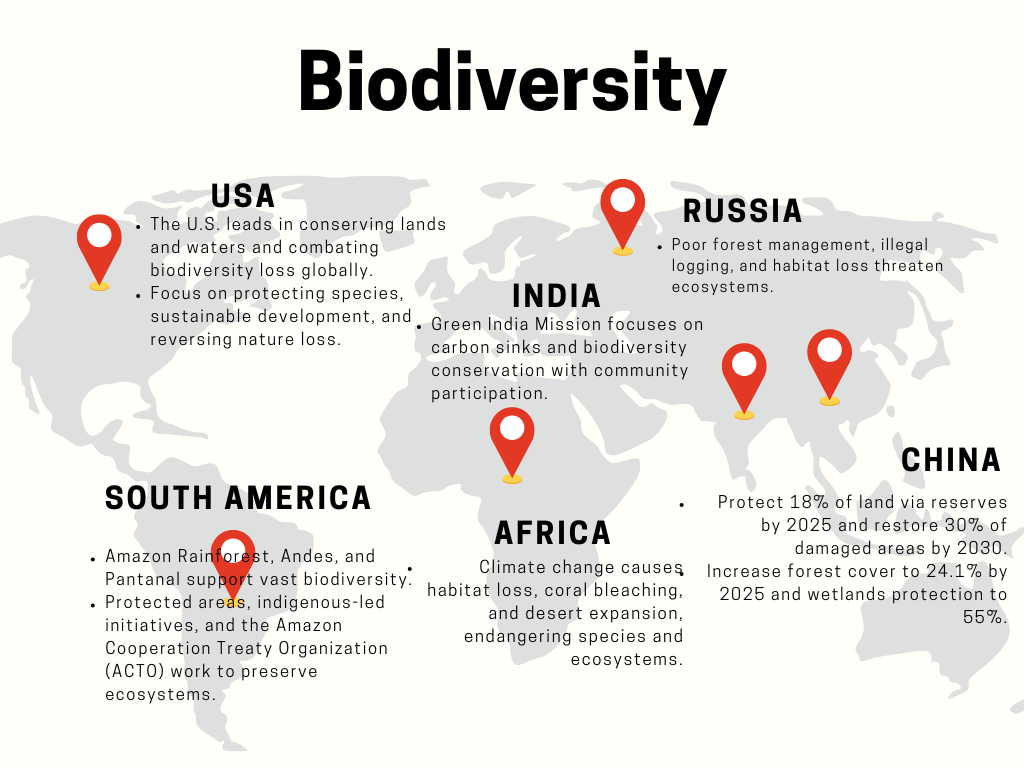
The strategy of renewable energy
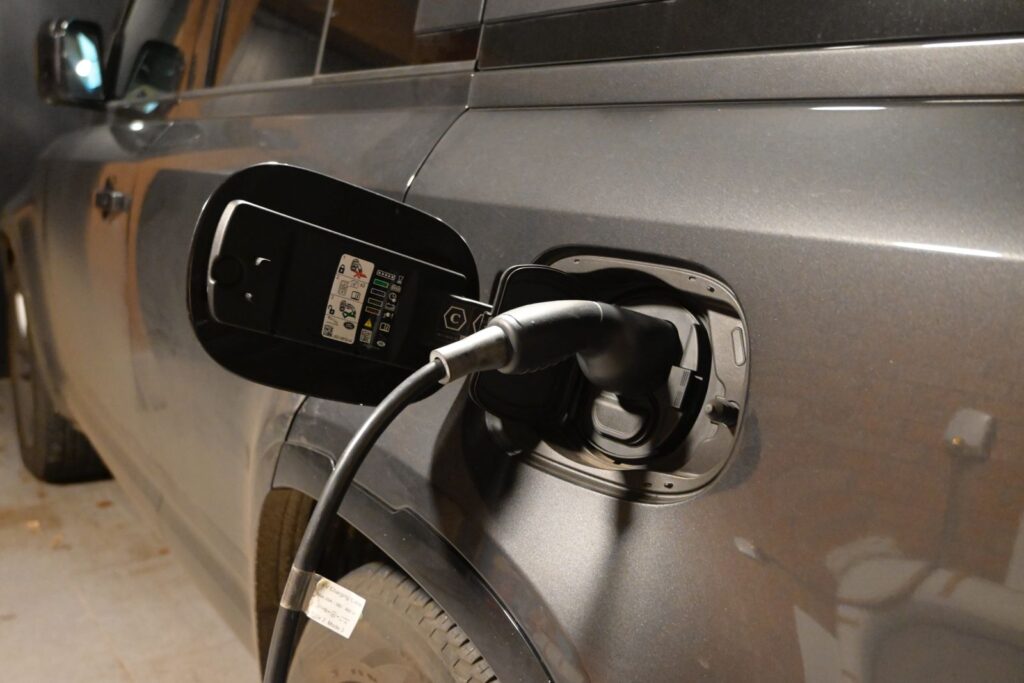

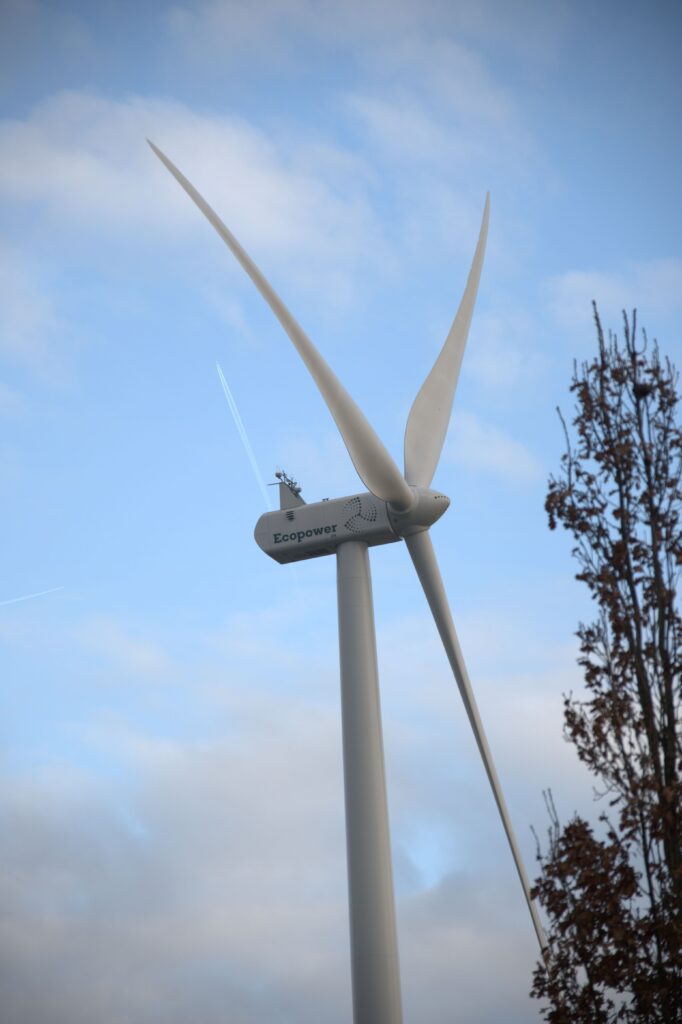
Africa
To reduce emissions the continent needs to increase their instalment of renewable energy. Africa has abundant solar, wind, and hydropower potential. Projects like South Africa’s Renewable Energy Independent Power Producer Procurement Programme (REIPPPP) and Kenya’s Lake Turkana Wind Power Project are notable. Scaling up renewable energy is essential to decarbonize. In 2022 Africa’s renewable energy generation capacity landed on 56 GW. The Nairobi Declaration states that by 2030 this capacity must be at least 300 GW.
China
China has invested a lot in solar, wind, and nuclear energy, making it a world leader in renewable energy. Right now, China is building more solar and wind power than the rest of the world combined. In 2023, China nearly doubled the amount of solar and wind energy it added compared to previous years. Together, wind and solar now make up 37% of China’s total energy capacity, which is 8% more than 2022.
China is also a big producer of electric vehicles (almost the biggest in the world) and is a leader in battery technology. However, the number of electrical vehicles owned by people in China is still relatively low, with only 5,6 electrical cars for every 1000 people.
USA
The United States is making significant progress in its transition to renewable energy. By 2023, over 20% of electricity was generated from sources like wind, solar, hydropower, biomass, and geothermal. This share continues to grow, with renewable energy surpassing coal generation for the first time in 2022. By 2025, solar energy is projected to increase by 75% and wind energy by 11%, reflecting the sector’s momentum.
The U.S. possesses abundant natural resources, capable of producing over 100 times its annual electricity demand. This highlights the vast potential of renewables to shape the nation’s energy future. However, challenges like modernizing infrastructure, advancing storage technologies, and aligning policies remain crucial for achieving a complete transition to sustainable energy.
Russia
Renewable energy plays a marginal role in Russia. Wind and solar power make up only 0.6% of the energy mix, compared to a world average of 13.5%. Although Russia started policies on solar and wind energy more than a decade ago, there have never been serious plans to significantly increase the share. Instead, natural gas dominates, presented as ‘clean’ by Russian officials, while not equalling renewable energy. Nuclear (20%) and hydropower (20%) play a larger role, but are outdated, with many installations dating back to Soviet times. Without structural changes, Russia will lag behind globally.
South America

South America has a lot of potential in renewable energy. Brazil for example, is leading in biofuels and also uses a lot of hydro energy. They also have a lot of countries who have rare metals/minerals who are used to make batteries and stuff like that. Some countries in South America use a lot of renewable energy. Also, there are a lot of indigenous people, tribes and protected nature, who don’t really use any fossils fuels. But this also makes it hard to change to renewable energy because these people are hard to change since they are protected by UNESCO.
India
The country is a global leader in solar energy, spearheading efforts through the International Solar Alliance, which promotes solar power expansion worldwide. Additionally, India ranks among the top producers of wind energy, with substantial wind farms concentrated in states like Tamil Nadu and Gujarat.
By 2030, India aims to achieve 500 GW of renewable energy capacity, with a strong emphasis on both solar and wind power. The country has already made significant strides, becoming one of the world’s largest markets for solar power installation, driven by large-scale solar parks and a robust solar rooftop program. India is also investing in innovative solutions like hybrid solar-wind projects and developing its energy storage capacity to ensure a reliable supply of renewable energy. These efforts are part of a broader strategy to reduce reliance on coal, improve air quality, and enhance energy security.
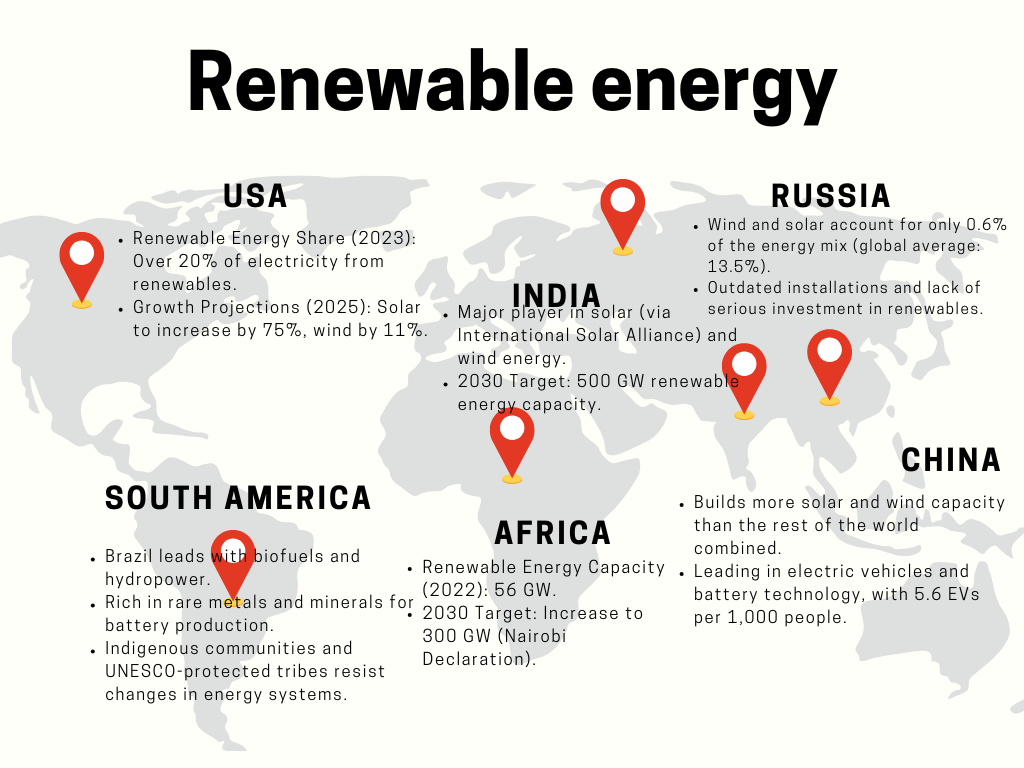
The possibility of industrial sustainability
Africa
Industrial sustainability in Africa is critical for balancing the continent’s growing economic needs with environmental protection and resource conservation. As Africa continues to industrialize and urbanize, sustainable practices can help reduce environmental impacts, support communities, and build long-term economic resilience.
China
China had set goals to move towards a low-carbon economy. It plans to peak its carbon emissions by 2030 and reach carbon neutrality by 2060, as part of its 14th Five-Years Plan. This shift will involve investing in clean energy, improving energy, and using green technologies. Through these efforts, China aims to reduce its carbon footprint, support sustainable growth, and contribute to global efforts to flight climate change.
Russia
Russia’s industry remains heavily dependent on fossil fuels, which hampers industrial sustainability. Although there are energy efficiency initiatives, such as modernisation of buildings and processes, these remain limited by a lack of investment and political priority. The emphasis on natural gas as a ‘transition fuel’ shows that Russia is sticking to traditional energy sources rather than investing in sustainable technologies. This has implications for both industry and the climate, as Russian companies feel little pressure to embrace cleaner methods, partly due to limited international engagement following the war in Ukrain.
South America
South America has plans which ensure that farmers farm their crops ecofriendly, when they do this they get an equal prize for their products. South America exports a lot of coffee and soy. They try to change up traditional agriculture techniques to newer ones who are more ecofriendly. Also they have a lot of wind and water, which they use to power their industry so It’s ecofriendly.
India
India’s industrial sustainability initiatives are pivotal in addressing climate change and ensuring long-term environmental health. Strict regulatory policies enforce environmental standards, driving industries to reduce emissions and minimize waste. The emphasis on resource efficiency optimizes the use of materials and energy, while the transition to renewable energy—especially solar and wind—accelerates to reduce reliance on fossil fuels. A circular economy model is being adopted, promoting recycling and reusing resources. Sustainable supply chains focus on responsible sourcing and ethical practices. Technological innovations foster green solutions, and CSR initiatives invest in environmental and community welfare. These combined efforts support India’s climate goals, such as achieving net-zero emissions by 2070 and generating 50% of power from non-fossil fuels by 2030.
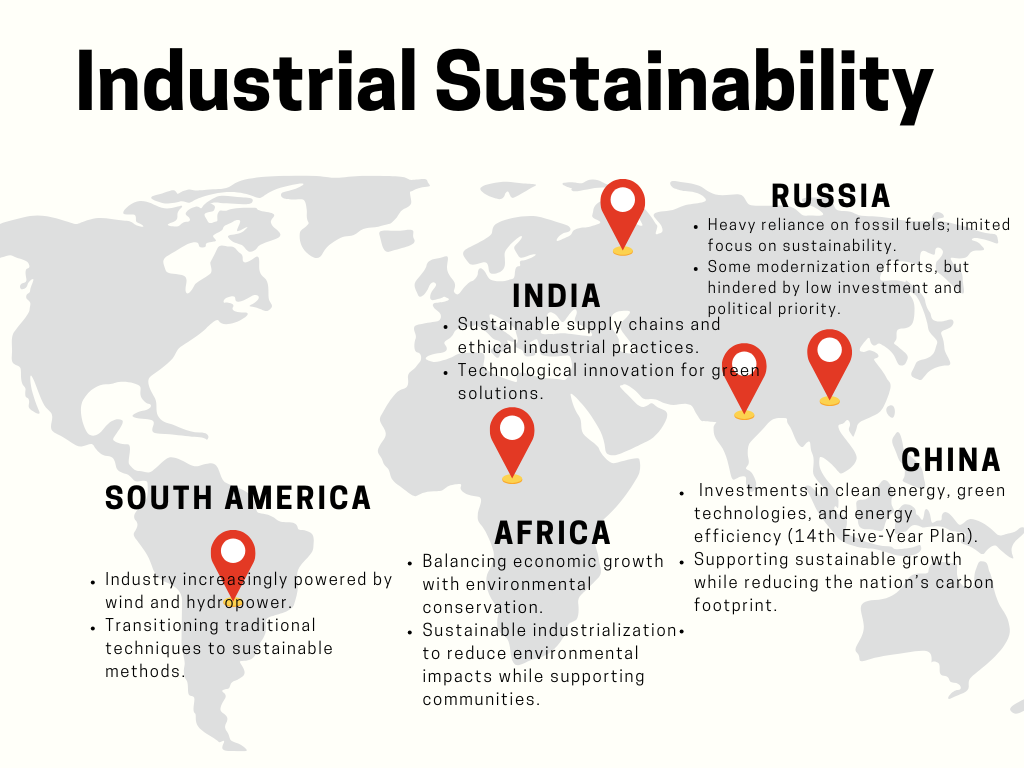
International teamwork makes the dream work
Africa
All 54 African countries are represented on the COP29. Claver Gatete, United Nations Under-Secretary-General and Executive Secretary of the Economic Commission for Africa (ECA) called to action: “The cost of inaction is far greater than the investment required to build a resilient and prosperous future for Africa.”
“Despite pledges at COP26 in Glasgow to double adaptation finance for developing countries, Africa receives only 3-4% of global climate finance, far below what is necessary to address its adaptation challenges.” Africa needs to receive more international support.
Did you know?
Uganda has updated its environmental legislation through the National Environment Act No. 5 of 2019, banning plastic carrier bags thinner than 30 microns. Additionally, the country has implemented extended producer responsibility, aligning with the polluter-pays principle.
China
China has been a key player in global efforts. It played an important role in securing the Paris Agreement in 2025, working closely with the United States during the Obama administration to build global support. Also, in 2021, as part of the Glasgow Climate pact (COP26), China and the U.S. signed a joint declaration the strengthen climate action during the 2020s. This agreement focused on areas like reducing methane emissions, increasing renewable energy, and tackling deforestation.
China and the EU also have a strong partnership on climate change, working together on renewable energy, green finance, and emissions trading systems. While they collaborate closely, tensions over trade and China’s coal use remain challenges.
Click here for the full interview
USA
If Donald Trump follows his previous approaches, U.S. climate actions will focus on fossil fuels, rolling back environmental regulations, and withdrawing from global agreements like the Paris Agreement. His second term will likely emphasize oil, gas, and coal production, which may slow progress on reducing emissions and increasing renewable energy.
Debora Van Nijnatten, a political science professor, explains, “The U.S. isn’t aiming to lead much, and once again, Europe is left holding the bag.” She suggests that Trump’s actions will weaken U.S. influence, leaving Europe to lead global climate efforts. However, state and local governments within the U.S. may step up in response.
In Europe, carbon border adjustment tariffs may challenge other nations, including the U.S., to strengthen their climate policies by making carbon-heavy imports more expensive. This may push the Trump administration to reconsider its position.

Russia
Russia is reluctant in international climate efforts. Although the country is a signatory to the Paris Climate Agreement, implementation remains weak. Sanctions and the war in Ukraine have further reduced commitment, reducing pressure on Russia to improve its climate policies. Previously, European regulations such as the Carbon Border Adjustment Mechanism (CBAM) could have forced Russia to reduce its emissions. But with reduced exports to Europe and the departure of Western companies, this incentive has largely disappeared. Russia remains mostly nationally focused, using its forests as a symbol of climate policy without taking concrete action.
South America
The strength and ambition of environmental policies are often shaped by a country’s economic situation. For example, resource-rich countries may prioritize extractive industries, sometimes at the expense of stricter environmental regulations. Additionally, countries facing economic hardship may lack the resources to enforce stringent policies. They also rely on the USA because they fund most of the projects and because of that they are influenced by the choices of the USA and the EU.
India
India is deeply engaged in global efforts to address climate change and promote sustainability. As a signatory to the Paris Agreement, India is committed to reducing emissions and limiting global warming. The country is also dedicated to achieving the United Nations Sustainable Development Goals (SDGs) by 2030. Through bilateral cooperation, India forms agreements focused on clean technologies, driving innovation and sharing sustainable solutions. Active participation in global forums like COP and G20 allows India to influence global climate discussions. Additionally, India attracts foreign investments in green technologies and facilitates technology transfer, further accelerating international climate action and fostering global sustainability.
Did you know?
India has partnerships with various international cities, such as New York and Berlin, and organizations to promote the development of sustainable cities. This includes initiatives such as the Smart Cities Mission, which focuses on improving infrastructure and reducing the ecological footprint of urban areas.
Youth representative Daan Van Den Berghe on COP29: A fight against fossil fuels and for a hopeful future

Young people took center stage in discussions about the planet’s future at the annual climate summit, COP29 in Baku. Daan Van Den Berghe, youth delegate from the Flemish Youth Council, played a vital role in making sure the voice of youth was heard during key negotiations.
In the audio, he reflects on the toughest challenges in reaching agreements on phasing out fossil fuels and shares the message he aimed to deliver on behalf of young people worldwide—one he hopes resonated with global leaders.

Conclusion
The EU is in a leading position in various areas of climate policy, although there is room for improvement. In the field of renewable energy, Europe is a leader, with ambitious goals and investments in clean technologies. In terms of biodiversity and emissions, there has been clear progress, but challenges remain, especially compared to countries like China and the US, which generate larger emissions. Internationally, the EU plays an important role in sustainability but must continue to collaborate with other major players like the US and China to achieve global climate goals. In short, the EU ranks highly, but global cooperation is essential for further progress.
“Overall, Europe has performed well among industrialized nations but faces pressure to meet its targets and support developing countries.” François Dejean, head of the Climate Advisory Board




